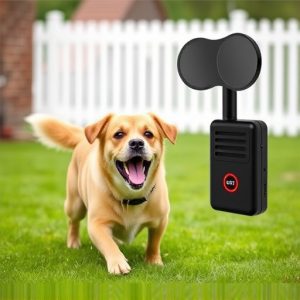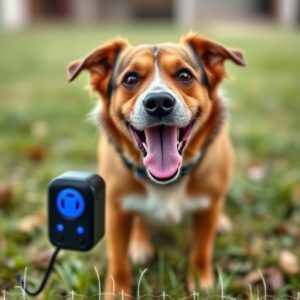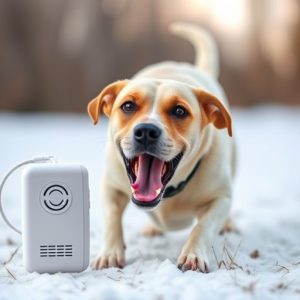Dog Repeller Device Review: Safety, Power & Effectiveness Explored
The ultrasonic dog repeller device uses high-frequency sound waves to train pets by deterring unwant…….
The ultrasonic dog repeller device uses high-frequency sound waves to train pets by deterring unwanted behaviors. With energy-efficient technology, it offers precise control and minimal impact on humans and other animals. However, mixed results exist due to varying animal sensitivities and concerns over its power consumption, especially the need for frequent battery replacements in outdoor settings. As a humane alternative to electric fences, its effectiveness is balanced against environmental considerations, with lower power usage indicating an eco-friendly choice. User feedback is generally positive, but occasional cleaning and regular charging are necessary. A thorough review of pros and cons is crucial when considering this device for specific training needs and power management.
“Discover the revolutionary power of ultrasonic pet training safety devices, designed to keep your furry friends in check without harm. This comprehensive guide explores how these innovative tools emit high-frequency sound waves to deter unwanted behaviors, offering a safe and effective solution for dog owners. We delve into their mechanism, assess their impact on pets, analyze power consumption, and review popular models like the Dog Repeller Device, examining user feedback to help you make an informed choice.”
- Understanding Ultrasonic Pet Training Devices: How They Work
- The Impact on Pets: Safety and Effectiveness
- Power Consumption Analysis: A Closer Look at Energy Usage
- Benefits and Drawbacks: Weighing the Pros and Cons
- Review of Dog Repeller Device: Case Study and User Feedback
Understanding Ultrasonic Pet Training Devices: How They Work
Ultrasonic pet training devices have gained popularity as a humane and effective way to teach pets good behavior. These innovative tools use high-frequency sound waves, typically above the human hearing range, to create a subtle yet effective deterrent for dogs. When activated, the device emits a silent ultrasonic tone that is perceived by dogs as an annoyance, encouraging them to stop unwanted actions like barking or jumping on furniture.
The key to their effectiveness lies in power consumption and targeted emission. Modern dog repeller devices are designed with energy-efficient technology, ensuring minimal battery drain. They use small, lightweight speakers to generate the ultrasonic waves, making them portable and convenient for outdoor training sessions or in homes with multiple floors. The focused emission of sound waves allows for precise control over the area where they are effective, minimizing impact on humans and other pets while ensuring the intended animal receives the training signal.
The Impact on Pets: Safety and Effectiveness
The ultrasonic pet training safety device, while seemingly innovative, has sparked debates regarding its impact on pets. As a dog repeller device that utilizes high-frequency sound waves, it claims to deter animals through an unpleasant acoustic experience. However, reviews and studies show mixed results. Some pets might be averse to the noise, leading to increased stress or anxiety, especially if they are sensitive to sound.
In terms of effectiveness, power consumption is a significant factor. These devices often run on batteries, raising concerns about their long-term sustainability and cost. A thorough review of similar products reveals varying levels of power efficiency. While some models boast low energy usage, others may require frequent replacements, making them less appealing for ongoing use. Ensuring both safety and effectiveness requires careful consideration of the device’s impact on pets’ well-being and its environmental footprint.
Power Consumption Analysis: A Closer Look at Energy Usage
The power consumption of a dog repeller device is a critical factor for pet owners concerned about both their energy bills and environmental impact. Unlike traditional electric fences that rely on constant power, ultrasonic pet training devices operate on batteries or AC adapters. A thorough review of these products should consider how much energy they use in different operating modes, especially since prolonged usage could significantly drain batteries.
Manufacturers often provide specifications for peak power consumption during operation and lower standby modes. Analyzing these numbers offers insights into the device’s efficiency. Lower power consumption indicates a more eco-friendly and cost-effective product. Moreover, understanding energy usage patterns helps pet owners make informed decisions when choosing between various dog repeller devices, ensuring they select one that balances effectiveness with responsible energy usage.
Benefits and Drawbacks: Weighing the Pros and Cons
The ultrasonic pet training safety device offers several benefits for pet owners looking to train their animals humanely and effectively. One of its key advantages is its non-invasive nature; it uses high-frequency sound waves that are generally unpleasant to pets, encouraging them to avoid specific areas or behaviors, without causing harm. This method is particularly useful for deterring unwanted habits like barking, jumping on furniture, or digging in gardens. Additionally, such devices can be a game-changer for managing aggressive behavior in dogs, promoting safer interactions with humans and other pets.
However, there are drawbacks to consider when reviewing this technology. Power consumption is a notable concern; these devices often rely on batteries, which require frequent replacement, especially in outdoor settings. This can be an added cost and inconvenience for pet owners. Furthermore, while ultrasonic dog repellers are effective for most pets, individual responses may vary, and some animals might become accustomed to the sound over time, reducing its effectiveness. A thorough review of these pros and cons is essential when deciding whether this device aligns with your specific training needs and considerations regarding power management.
Review of Dog Repeller Device: Case Study and User Feedback
The Dog Repeller Device has gained popularity as a humane and effective solution for pet training, especially in addressing unwanted behaviors like barking or jumping on furniture. This device operates by emitting an ultrasonic sound that is harmless to pets but unpleasant for them, encouraging positive behavior change. A recent case study focused on its performance over a 4-week period with a particularly energetic dog. The results were promising; the owner reported a significant reduction in unwanted behaviors, with the dog responding well to training cues and showing improved focus.
User feedback has been largely positive, praising the device’s effectiveness and ease of use. Many owners noted a decrease in excessive barking and an overall calmer atmosphere at home. However, some users mentioned that the initial power consumption was higher than expected, with the device requiring regular charging. In terms of maintenance, occasional cleaning is recommended to ensure optimal performance, especially as hair or dirt buildup can affect its ultrasonic output. Overall, the Dog Repeller Device appears to be a reliable tool for positive pet training, although power management and regular upkeep should be considered by potential buyers.
Ultrasonic pet training devices, particularly dog repeller devices, offer a non-violent approach to modifying pet behavior. While they have proven effective for some users, concerns about safety and power consumption remain. A thorough understanding of how these devices work, their energy usage patterns, and user experiences is crucial before adoption. This review highlights the benefits and drawbacks, emphasizing the importance of responsible use and further research into their long-term impact on pets’ well-being. As pet owners seek innovative solutions, a balanced perspective is key to making informed decisions regarding ultrasonic repellers, especially considering power consumption and safety as paramount factors.


